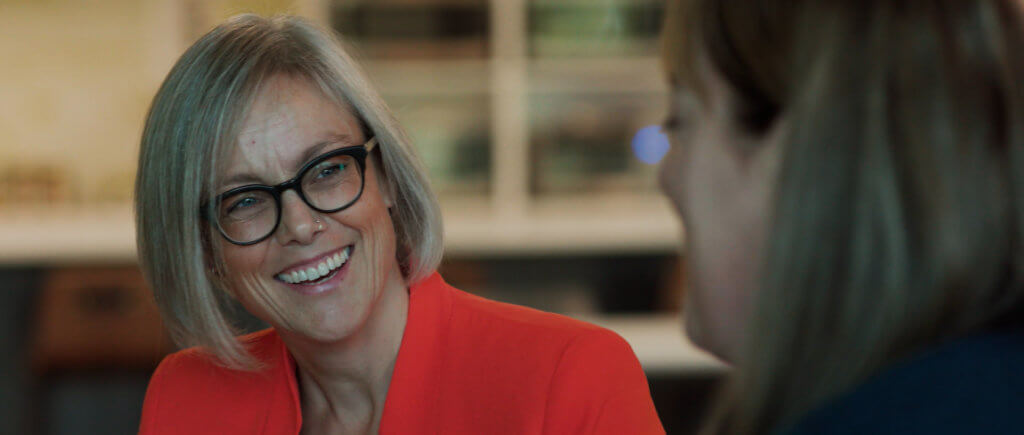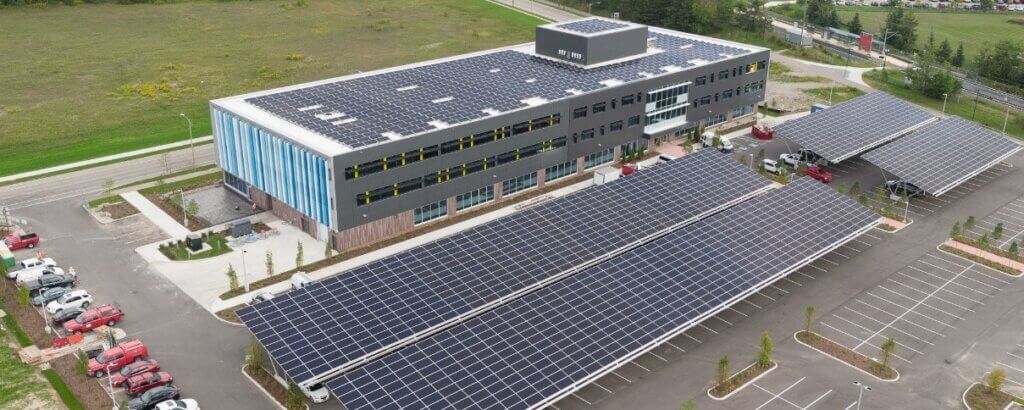Strengthening Waterloo’s Innovation Corridor
MEDI students craft bold visions for a vibrant David Johnston Research + Technology Park This story was originally published on…

Building and scaling a business takes energy. But we’re not just talking about the internal energy that helps founders start, developers build, and salespeople connect with customers. We’re talking about the energy it takes to power that business for all those tasks. As a company scales, so does its water and energy (electricity, natural gas, gasoline) requirements – and more consequently – so does its carbon footprint.
But it doesn’t have to be that way. Since 2008, Sustainable Waterloo Region has helped businesses grow and increase their profitability while reducing their impact on the environment and energy usage. Their mission is to catalyze transformation to sustainable energy systems, mobility, and buildings to build a cleaner, more diverse economy.
Sustainable Waterloo Region’s Executive Director Tova Davidson said the organization works at the intersection of economics and the environment. “We know that the most profitable businesses in the world – all of them, without exception – have targets to reduce their impact and publicly report their environmental impact,” said Davidson. “A sustainable business is actually a more profitable business.”
Over the last seven years, Davidson has worked with businesses and organizations to show how sustainability leads to more profitability. “One way is that if you use less energy, your operating costs are less – it’s that simple.”
“We know that the most profitable businesses in the world – all of them, without exception – have targets to reduce their impact and publicly report their environmental impact. A sustainable business is actually a more profitable business.”
Tova Davidson, Executive Director, Sustainable Waterloo Region
Davidson was attracted to the role at Sustainable Waterloo Region after a career path that took her from a Master’s in Philosophy to a Roger’s call centre to becoming the VP of a growing marketing company in Guelph. After a few years at the marketing company, Davidson had a revelation. “Around my late 30s, I didn’t really want to be a marketer anymore. It’s not what I thought my life would be. It was the path that I took, but it wasn’t my intention.”
Thinking back to what she enjoyed through school and her career, Davidson kept coming back to the key thing that drove her. “I always knew I wanted to make the world a better place. I thought maybe I wanted to go and dig wells or work in clean water projects in Sub Saharan Africa, but it’s not my strength,” said Davidson. She decided that working in a non-governmental agency would be the right path forward. Keeping her eyes open on different opportunities, Davidson happened upon a LinkedIn posting for the Executive Director role at Sustainable Waterloo Region. “It was interesting. It was business and sustainability and business strategy and return on investment – all these things I was already doing – but to a purpose that was very deeply rooted in my core values.”
Leading the Sustainable Waterloo Region team, Davidson gets to see those core values put to use with every engagement. As a social enterprise, not-for-profit, the organization runs like any business. Instead of public funding, Sustainable Waterloo Region charges for their programs. “All of our programs are about measurement and publicly reporting on targets,” said Davidson. “Businesses measure what matters to them, and manage what they measure.”

Davidson’s most asked questions are from businesses wondering where they will see benefits from sustainability initiatives. “There are four places that we find organizations get a return on an investment on their sustainability actions; operating costs, risk management, green branding, and employee retention and attraction.”
Operating costs are the clearest example of return on investment. As a business makes improvements to its energy usage, its operating costs will decrease. Davidson gave an example of a steel fabricator in Cambridge, Ontario, who decided to go completely carbon neutral. “86% of the reduction was organic reduction. They changed their processes and made improvements to the building infrastructure,” added Davidson. “They doubled the physical size of the building and didn’t lay a single person off – including through the downturn of 2008.” Many of the changes were very low tech, too, adding up to millions of dollars in savings. “They’re saving $600 a month with a different coffee pot, because they did the assessment as to how much energy and coffee was being wasted.”
With risk management, the benefits from implementing sustainable programs are being prepared for the unknown. “If you think about what the government is doing, and where your sectoris going with things like carbon tax that have now been passed to be legal by the Supreme Court, we know that there will be reporting requirements coming,” Davidson said. Being prepared also sets businesses up for success when selling into other communities. “If you want to be a business selling into other jurisdictions, being able to say this is what you do and sharing your environmental commitment is a risk management piece.”
Green branding does more than benefit your company’s marketing efforts. While it can help you stand out from competitors by demonstrating your focus on sustainability, it’s also a primary driver of employee retention and attraction. “Employees want to work in places that are aligned with their values,” said Davidson. This connection on values is essential when connecting with Millennial and Gen Z employees. Both groups are known for a desire to align their personal values with their employer values.
Beyond attracting employees, Davidson said sustainable initiatives are also great opportunities for leadership development. “These can be training grounds for future leaders,” Davidson added. “Let’s say you don’t have a ton of mobility options open, if you put them in a green team, they then have a leadership role. It gives them that ownership over the organization and the direction – especially if you truly empower them.”
Sustainable Waterloo Region helps businesses with climate change mitigation, including energy use, mobility, and green buildings. Energy use includes more than electricity, natural gas, gasoline, and fuel oils . There is a focus on waste and water reduction due to the high carbon cost of water usage and purification, and the waste management processes associated with this. When it comes to mobility, Davidson said businesses need to ask themselves how they can get goods and people around in a sustainable way. “It can be electrification, it could be active transportation, it can be public transportation,” added Davidson. Green buildings are close to home for Sustainable Waterloo Region. Their office is inside Cora Group’s evolv1 – Canada’s first zero-carbon office building. Sustainable Waterloo Region worked to drive this project, outlined in their 2013 strategic plan, forward in partnership with the Cora Group, EY Canada and the R+T Park teams. Located near the Grand River Transit ION light rail transit station, evolv1 is the David Johnston Research + Technology Park’s newest space.
Learning from best practices across Canada, Sustainable Waterloo Region also works to find solutions to make existing buildings more sustainable. One example is a current retrofit project within the R+T Park that adds a covered parking lot with a 1,000-panel solar array to the Cora Building, home to AGFA, SSIMWAVE, and eleven-x. The project partners include the Cora Group and VCT Group, the same duo who built evolv1’s solar array covered parking structure. “These solar covered parkings are a great example. They generate clean energy that is fed back to the grid. They then get net metering, which means that they’re not paying as much for their energy because they get money back for what they’re generating,” said Davidson.
There are other advantages to the project beyond energy savings. They reduce the heat island effect by providing more shade. There’s also a benefit to employees because their cars are covered from the elements. “All of a sudden, it’s more attractive for potential tenants and employees,” Davidson added.
Even with such clear benefits from sustainable projects, Davidson and Sustainable Waterloo Region still find it difficult to convince businesses to make changes. “The way we do our finances is not conducive to progress,” said Davidson. “It’s because we have a capital budget and we have an operating budget – and never the two shall meet. People will say their capital budget is this, and even if it’s going to save them in operations over a long term, they won’t make the financial case because they don’t consider the operating budget in their capital planning.”
One way to change this mindset is to do a life cycle assessment on a new project or a retrofit to make the business case more apparent. “It’s then a much easier thing to understand and to integrate,” added Davidson.
The other challenge that Sustainable Waterloo Region deals with isn’t fiscal – it’s perception. “There’s this perception that sustainability is going to take something away from you or it costs a lot,” said Davidson. “But if you were to ask Adrian Conrad from Cora Group, he would say that the delta from going from a LEED Platinum to a Net Zero building was not that big.”

Sustainable Waterloo Region is currently working on its next big transformational idea. They’ve worked with over 30 sustainability experts to narrow down to a list of nine major transformational projects that have been presented to their board. The list was refined, and the organization will be bringing in the community to learn more at an event later this month. “Everybody who’s a stakeholder is welcome to come to this, we’re going to have a vote and the community is going to decide what are the top two or three things as to Sustainable Waterloo Region is going to try to build a business case for and try to move forward.”
Davidson wants business leaders to know that not thinking about sustainability is putting their business at risk. “Even if you don’t care about sustainability, there’s a market that wants you to care about it”, said Davidson. “I’m not going to come into most businesses and talk to them about their carbon footprint; I’m going to talk to them about their business pain points and how sustainability action can help them solve those pain points.” That is the power of building a better, more efficient business, it is good for your employees, it is good for your brand, it is good for the bottom line, and it is good for the world. What better reason do you need? Check them out at sustainablewr.ca.